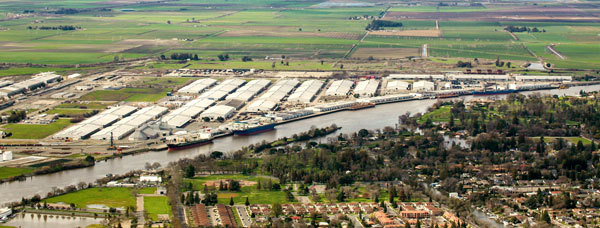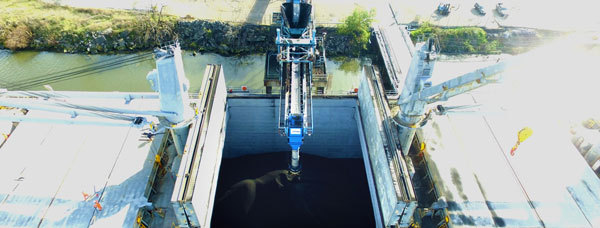Building Out For New Business










PHOTO: PORT OF BELLEDUNE
February 27, 2021
BY Luke Leroy
As the North American wood pellet export industry continues to grow, ports on every shore of North America are strategizing to accommodate market momentum and bolster more business. From Georgia to Washington, and from New Brunswick to California, major investments have been made by ports striving to show prospective clients that they have the capabilities and wherewithal to assist in meeting overseas contract obligations.
Port of Stockton
Located on the banks of the San Joaquin River roughly 75 nautical miles from inland from the pillars of the Golden Gate Bridge, the Port of Stockton claims the title of fourth largest port in California.
Little more than a year ago in December 2019, the port announced that its first wood pellet shipment was successfully loaded onto the M/V Global Serenity—roughly 2,000 metric tons (MT) of torrefied wood pellets—destined for Japan as a trial shipment of Stockton’s planned expansion into the wood pellet industry.
But the port’s movements began long before that trial shipment. “As early as 2016, the Port of Stockton was contacted by several potential wood chip and log shippers, and it’s a market we’ve been chasing since that time,” says Pete Grossgart, marketing manager for the Port of Stockton. “There have been three or four entities that got to the point of picking a site at the port, but ultimately those entities were unable to make the numbers work. As for the future, we’re in negotiations with pellet manufacturers and exporters to locate at the port—it’s early yet, but we’re hopeful.”
Despite the lack of a formal relationship, the port is indeed a formidable suitor for exporters looking to ship wood pellets from its banks. As a potential wood pellet export customer, Stockton offers many suitable amenities. “We currently can offer ‘old school’ solutions for loading and moving pellets, such as portable conveyors, stackers, near- and on-dock storage … including covered storage,” Grossgart says. “However, there are plans to develop a state-of-the-art facility, one capable of handling significant tonnage of a variety of bulk cargoes, with pellets—again, hopefully—being one of the foundational cargoes handled.”
As it currently sits, the Port of Stockton is dual-served with rails from both the BNSF and UP, with switching services provided by the Central California Traction Co. The port is approximately 2 miles from Interstate 5 (I-5), the main north-south artery that services the West Coast, as well as residing within a few miles of I-580, CA-4 and CA-99. Plus, Stockton is less than an hour from I-80, which is the main east-west artery in northern California. “The Port has 15 berths, three licensed stevedores and an experienced ILWU workforce,” Grossgart adds. “Additionally, we have available acreage, depending on the outcome of current negotiations, 100 to 200 if successfully concluded, 500-plus if unsuccessful.”
With a rich history dating back to 1933, the Port of Stockton appears ready and well-suited geographically, logistically and structurally to deliver wood pellets to the front steps of Asia’s growing demand. “Our continued growth adds contributes to the regional economy,” says Port Director Richard Aschieris, in a recent interview with Pellet Mill Magazine. “The Port of Stockton supports over 10,000 family-wage jobs. We made a strategic move to diversify our cargo base and began making focused investments in our infrastructure over 10 years ago.”
Port of Belledune
Located in the protected Chaleur Bay, along the northeastern shores of New Brunswick, the Port of Belledune is strategically located near the Northumberland Strait, offering Canada’s Atlantic coast a deepwater facility capable of year-round port solutions.
Advertisement
Advertisement
As a longtime service port of the energy, mining and mineral, agriculture and modular sectors—and previously servicing the forest commodities with solutions for wood pulp, wood chips and lumber—the Port of Belledune’s ventures in wood pellets is still new, yet extensive.
The Port of Belledune has rail connectivity directly on the marine terminals, making it a principal location for an export hub along the eastern coast of Canada. In addition, the Trans-Canada Highway is located just three miles from the marine terminal, accessed via a direct and uncongested travel corridor. The Port of Belledune owns more than 1,000 acres of industrial zoned land adjacent to the port, offering ideal geographic logistics for future development opportunities. All this—with the obvious inclusion of sea-shipping infrastructure—Belledune offers strong consolidation and export hub services for wood pellets.
“The Port of Belledune became involved with wood pellets in 2007, when Shaw Resources opened a wood pellet facility in Belledune, roughly 3 kilometers from the port,” says Jenna MacDonald, vice president of marketing, communications and government relations for the Belledune Port Authority. “Shaw chose the location based on several factors: being next to a sawmill where they could get sawdust, having the ability to purchase and retrofit an existing facility and, of course, being located very close to a seaport.”
In a move to grow with industry momentum, the Port of Belledune built a warehouse for the Shaw Resources’ pellets, and the first shipments left the port in 2008. “Since that time, three more wood pellet customers have started using the Port of Belledune for export, making it Atlantic Canada’s leading wood pellet export port,” MacDonald says. “Shaw Resources, Groupe Savoie, JD Irving (Great Northern Pellets) and GDS all use the Port of Belledune as their export terminal.”
As a serious wood pellet exporter, Belledune took initiative to ensure the port offered superior material handling, storage and ship-loading resources. “QSL is the terminal operator handling all wood pellet exports at the Port of Belledune,” MacDonald says. “During the past 13 years, the Port and QSL have invested in many different storage facilities and pieces of loading equipment to ensure wood pellets are handled in the best, safest way possible.”
Since investing in the wood pellet industry in 2008, the port has seen significant growth in the sector, currently totaling roughly 26 percent of the port’s total export. “During the past 13 years, there has been steady growth, shipping just over 20,000 MT of wood pellets in 2008, and more than 170,000 MT in 2020,” MacDonald adds. “In addition, 2021 will see the addition of a fourth wood pellet shipper and is expected to be a record-breaking year … with more than 300,000 MT of wood pellet exports projected.
Advertisement
Advertisement
“The Port of Belledune is approaching a milestone that all of the shippers (Shaw Resources, Groupe Savoie and Great Northern Pellets) are part of,” MacDonald continues. “We are one vessel away from exporting 1.5 million MT of wood pellets through the Port of Belledune.”
More Ports of Note Port of Olympia
Servicing the Pacific Northwest, the Port of Olympia is built upon a 70-acre facility that features complete breakbulk services and a container yard, a 76,000 square-feet on-dock storage warehouse, on-dock rails services by both UPRR and BNSF, and three deep-water berths.
From breakbulk to containerized cargo, and from forest products to livestock, the Port of Olympia has positioned itself as a full-service solution capable of handling nearly any port-transportation service needs. Offering a facility that’s “big enough to offer the services of larger ports, but small enough to serve your customized needs,” the port’s location between Portland, Oregon and Vancouver, British Columbia, is prime for servicing the forestry industry of the Northwest, and potentially, the growing wood pellet market.
Regarding dock facilities and freight-moving logistics, Olympia’s three deep-water berths total more than 1,700 feet, with a load capacity of 1,000 pounds per square foot and direct rail-discharge capabilities. A 140-ton mobile harbor crane, bulk yard handling equipment, front-end loaders and log handles cater specifically to the Port’s forestry clients, as does the bulk-cargo conveyor system. The port also offers easy access to Interstate 5 less than a mile away, a dock-side warehouse and a tug and barge company on-site.
Though local reports indicated that, in 2018, the port was in conversations with a customer intending to ship pellets to Japan, the potential tenant ultimately decided to go elsewhere.
East River Terminal—Port of Brunswick
In August 2011, the Georgia Ports Authority, in conjunction with terminal operations company Logistec, announced a shared investment in the East River Terminal of Brunswick, in an effort to expand its wood pellet export capabilities. By April 2013, tonnage moving through the East River Terminal increased 14% as compared to the same time frame the previous year, reaching nearly 670,000 tons, led by biomass fuels.
In fiscal year 2019, Logistec moved 1.2 million tons of bulk cargo through the East River Terminal in Brunswick, which it reports as 20% increase associated largely with the movement of wood pellets, perlite and peanut pellets.
Strategically located to serve Georgia’s biomass industries, the Port of Brunswick has developed specialized storage and handling facilities specifically for those products, investing nearly $80 million during the past decade to rebuild and modernize the site. New warehouses, an overhaul of the bulk load-up system, construction of a new ship loader, and largely redesigned conveyor system.
Another critical piece of the port’s efforts to be better suited for wood pellet export included the Georgia Ports Authority’s dredging of an additional 6 feet—to a new depth of 36 feet—to accommodate the terminal’s capabilities of handling larger ships for the export of wood pellets. “With the expansion and the deepening of the channel down to 36 feet, we are capable at this time of moving close to anywhere from 35,000 to 40,000 tons of wood pellets in a vessel,” according to David Proctor, Logistec’s terminal director. “There are economies of scale with the larger-size vessels, and this additional draft allows us to attract a new target market when serving the large-size utility companies overseas.”
Author: Luke LeRoy
Freelance writer, Pellet Mill Magazine
www.biomassmagazine.com/pellet-mill-magazine
Upcoming Events





